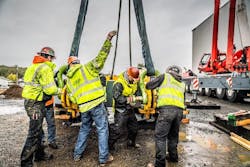Rigging is a common operation on many job sites, but it’s also a dangerous business if not done right. At LGH, we take safety seriously, and we hope you do. This won’t cover everything you need to know about rigging, and it isn’t a substitute for proper training. However, below, you will find five basic rules intended to help you reduce hazards during your next rigging project.
Determine the Weight of the Load
The first step in safe rigging practice is to determine the weight of the load to be rigged and lifted. Knowing the weight of the load is important so you can compare it to the rated capacities of the lifting and rigging equipment you are using. In some cases, it may be obvious that the load is too light to exceed equipment capacities. Other times, it may be questionable if the load can be lifted safely. It’s during these times that you will need to establish the weight of the load so it can be compared to the rated capacities of the lifting or rigging equipment. Product specifications, including weight, are often provided or can be acquired from the manufacturer or supplier. Certain products may require you to do simple calculations to determine the weight.
Determine Proper Hitch Based on Load Type
There are three basic types of hitches: a vertical hitch, a choker hitch, and a basket hitch. Selecting the right hitch to support the load is a critical part of safe rigging. For example, a single choker hitch would not fully support a stack of loose pipes. When the lift starts, the sling would tighten around the sides and bottom of the stack but remain loose on top, leaving the potential for pipes on top of the stack to fall. A 2-sling double wrap choker hitch or a 2-sling double wrap basket hitch would be a much safer choice since it would tightly secure all the pipe for lifting.
Select the Right Sling Based on Load Type
There are a few factors to consider when choosing the right sling-type for your load. Will the sling keep the load secure and stable? Is the sling compatible with the rigging hardware and hitch you have selected? Is the rated capacity of the sling fitting for the load weight? There are several types of slings, each with their pros and cons and varying rated capacities. Some of the most frequently used are synthetic web slings, synthetic round slings, wire rope slings, and steel chain slings. Understanding which sling is the best for your load type is another crucial part of rigging safety.
Select the Right Hardware for the Load
Selecting the right hardware for each specific rigging application is just as important as selecting the right hitches and slings. There are several types of hardware, but the selection process is the same for some of them, including hooks, shackles, and eyebolts. That’s because these are rated based on in-line loading. Be aware, however, that the rated capacity changes when angles are involved. When selecting hardware for a particular rigging application, ask yourself: Could this hardware damage the equipment that is being lifted? Is this hardware compatible with the sling? Is this hardware designed to be strong enough to perform the work safely and lift the load securely?
Pay Close Attention to Detail
Before and during a lift, several steps require special attention to detail to ensure that the lift can be completed safely.
- Attach tag lines to the load to keep it from swinging out of control during the lift. Use as many tag lines and trained tag line operators as necessary to safely control the load.
- Check for obstructions in the path of a moving load. Consider where the load needs to be delivered in relation to where it is being lifted, then look for any obstructions that could hinder the moving load. If you discover a possible obstruction, communicate with your operator to ensure they are aware of it and have chosen a safe path for the load to travel.
- Clear the area of workers not associated with the lift. Establish a signal for workers in the area so they will know when the lift is about to occur. Ensure they know to stay clear of the lift area and path of travel until the lift is completed.
- Establish communication with your operator. Be sure that a form of communication is established between the rigger and the operator. Ensure they are both familiar with the same verbal and hand signals in case vital information needs to be quickly relayed during the lift.
- Test the load. Once you have secured the area and completed the necessary rigging, have your operator slowly raise the load a few inches at a time. During this test, you can observe how the rigging equipment is performing and if the rigging has been properly placed in the load’s center of gravity. If you notice any issues or are unsure whether the load can be lifted safely, signal the operator to set the load back down and re-rig it before testing again.
For any questions regarding selecting the right rigging equipment for your next project, please reach out to your local representative or give us a call at 800-878-7305 to speak with one of our rental specialists.
Editor's Note: Scranton Gillette Communications and the SGC Infrastructure Group are not liable for the accuracy, efficacy and validity of the claims made in this piece. The views expressed in this content do not reflect the position of the Roads & Bridges' Editorial Team.



